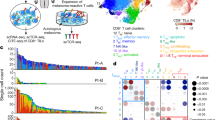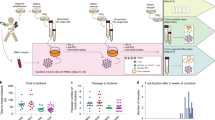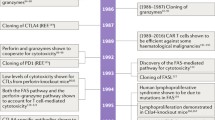Abstract
Using the chromium release assay and the single cell assay in agarose, we study the cytotoxic reaction of the MHC-restricted T lymphocyte clones P89:15 and P1:3, which recognize distinct but specific tumour antigens on the surface of syngeneic P815 mastocytoma cells. We propose a mathematical model which describes these experiments, accounts for the strongly non-Michaelian behaviour of the reaction and permits us to estimate the kinetic parameters characterizing effector-target conjugation and lethal hit delivery. The results show that the binding and lytic activity of effector cells is modulated by the number of targets bound to them. The binding of a second target by an effector having already a target bound is facilitated; on the other hand, an effector having bound two targets delivers a lethal hit more slowly than one with a single target bound. We investigate the role of these kinetic properties in the competition between the process of tumour progression due to cancer cell replication and the process of tumour regression due to T lymphocyte cytotoxic activity. For both clones, we estimate the effector-target ratio beyond which rejection prevails. This ratio is nine times larger for P1:3 than for P89:15. Furthermore, our analysis suggests that there exists an optimal specificity minimizing this ratio. Deviations from this optimum, be it in the sense of an increase or decrease of specificity, tendsto stabilize the tumoural state: a situation which in the broader context of the immune response evolution and regulation can be viewed as animmune response dilemma.
Similar content being viewed by others
Literature
Belldegrun, A., M. Muul and S. A. Rosenberg. 1988. Interleukin-2 expanded tumor-infiltrating lymphocytes in human renal cell cancer: isolation, characterization and anti-tumor activity.Cancer Res. 48, 206–214.
Berke, G., D. Gabison, and M. Feldman. 1975. The frequency of effector cells in populations containing cytotoxic T lymphocytes.Eur. J. Immunol. 5, 813–818.
Berke, G. and D. Rosen. 1987. Are lytic granules and perforin 1 involved in lysis induced byin vivo primed peritoneal exudate cytolytic T lymphocytes?Transplant. Proc. 19, 412–416.
Bonavida, B., T. P. Bradley and E. A. Grimm. 1983. The single-cell assay in cell-mediated cytotoxicity.Immunol. Today 4, 196–200.
Boon, T., A. Van Pel and E. De Plaen. 1989. Tum-transplantation antigens, point mutations and antigenic peptides: a model for tumor-specific transplantation antigens.Cancer Cells 1, 25–28.
Brunner, K. T., J. Mauel, J. C. Cerottini and B. Chapuis. 1968. Quantitative assay of the lytic action of immune lymphoid cells on51Cr-labelled allogeneic target cells in vitro, inhibition by isoantibody and by drugs.Immunology 14, 181–196.
Callewaert, D. M., D. F. Johnson and J. Kearney. 1978. Spontaneous cytotoxicity of cultured human cell lines mediated by normal peripheral blood lymphocytes. III. Kinetic parameters.J. Immunol. 121, 710–717.
Callewaert, D. M. and N. H. Mahle, 1985. Kinetic models for natural cytotoxicity and their use for studying activated NK cells. InMechanisms of Cytotoxicity by NK Cells. R. B. Herberman and D. M. Callewaert (Eds), pp. 381–395. London: Academic Press.
Flamand, V., C. Biernaux, M. Van Mechelen T. Sornasse, J. Urbain, O. Leo and M. Moser. 1990. Immune Surveillance: both CD3+ CD4+ and CD3+ CD8+ T cells controlin vivo growth of P815 mastocytoma.Int. J. Cancer 45, 757–762.
Garay, R. P., and R. Lefever. 1978. A kinetic approach to the immunology of cancer: stationary state properties of effector-target cell reactions.J. theor. Biol. 73, 417–438.
Garcia-Peñarrubia, P., F. T. Koster, A. D. Bankhurst and J. Galvez. 1989. Model for population distributions of lymphocyte-target cell conjugates.J. theor. Biol. 138, 77–92.
Garcia-Peñarrubia, P., F. T. Koster, A. D. Bankhurst and J. Glavez. 1989. Effect of conjugate size on the kinetics of cell-mediated cytotoxicity at the population level.J. theor. Biol. 138, 93–115.
Golstein, P., E. T. Smith. 1976. The lethal hit stage of mouse T and non-T cell-mediated cytolysis: differences in cation requirements and characterization of an analytical “cation pulse” method.Eur. J. Immunol. 6, 31–37.
Golstein, P., C. Foa and I. C. M. MacLennan. 1978. Mechanism of T cell-mediated cytolysis: the differential impact of cytochalasins at the recognition and lethal hit stages.Eur. J. Immunol. 8, 302–309.
Grimm, E., and B. Bonavida. 1979. Mechanism of cell-mediated cytotoxicity at the single cell level. I. Estimates of cytotoxic T lymphocyte frequency and relative lytic efficiency.J. Immunol. 123, 2861–2869.
Hiernaux, J., R. Lefever, C. Uyttenhove and T. Boon. 1986. Tumor dormancy as a result of simple competition between tumor cells and cytolytic effector cells InParadoxes in Immunology, G. W. Hoffmann, J. G. Levy and G. T. Nepom (Eds), p. 95–109. Boca Raton: CRC Press.
Howe, R. C. and J. H. Russell. 1983. Isolation of alloreactive CTL clones with cyclical changes in lytic activity.J. Immunol. 131, 2141–2146.
Howe, R. C. and J. H. Russell. 1985. Analysis of the binding and post binding activities of an inducible cloned CTL line at the population and single cell level.J. Immunol. 134, 2922–2929.
Kuo-Li, P. S., L. A. Sung, M. Crimmins, S. J. Burakoff and S. Chien. 1986. Determination of junction avidity of cytolytic T cell and target cell.Science 234, 1405–1408.
Lefever, A. V. and R. L. Truitt. 1986. Kinetic analysis of cloned cytotoxic T lymphocyte reactivity against normal and leukaemic target cells.J. Immunogenet. 13, 275–285.
Lefever, A. and S. Micha. 1989. Kinetic analysis of lymphokine-activated killer (LAK) cells: lytic parameters and determination of LAK cell frequency. Scand.J. Immunol.29, 417–426.
Lefever, R. and R. Garay, 1978. Local description of immune tumor rejection. InBiomathematics and Cell Kinetics, A.-J. Valleron and P. D. M. Macdonald (Eds), Series Developments in cell biology, Vol. 2, pp. 333–340. Amsterdam: Elsevier/North Holland Biomedical Press.
Lefever, R., J. Hiernaux and P. Meyers. 1989. Evolution of tumors attacked by immune cytotoxic cells: the immune response dilemma. InTheoretical Models for Cell to Cell Signalling, A. Goldbeter (Ed.), p. 315–333. London: Academic Press.
MacDonald, H. R., A. L. Glasebrook and J-C. Cerottini. 1982. Clonal heterogeneity in the functional requirement for Lyt-2/3 molecules on cytolytic T lymphocytes: analysis by antibody blocking and selective trypsinization.J. exp. Med. 156, 1711–1722.
Macken, C. A. and A. S. Perelson. 1984. A multistage model for the action of cytotoxic T lymphocytes in multicellular conjugates.J. Immunol. 132, 1614–1624.
Martz, E. 1977. Mechanism of specific tumor cell lysis by alloimmune T lymphocytes: resolution and characterization of discrete steps in the cellular interaction.Contemp. top. Immunobiol.7, 301–361.
Merrill, S. J. 1982. Foundations of the use of an enzyme-kinetic analogy in cell-mediated cytotoxicity.Math. Biosci. 62, 219–235.
Merrill, S. J., and S. Sathananthan. 1986. Approximate Michaelis-Menten kinetics displayed in a stochastic model of cell-mediated cytotoxicity.Math. Biosci. 80, 223–238.
Moscovitch, N., Z. Grossman, D. Rosen, G. Berke. 1986. Maturation of cytolytic T lymphocytes.Cellular Immunol.102, 52–67.
Mukherji, B., A. Guha, N. G. Chakraborty, M., Sivanandham, A. L. Nashed, J. R. Sporn and M. T. Ergin. 1989. Clonal analysis of cytotoxic and regulatory T cell responses against human melanoma.J. exp. Med. 169, 1961–1976.
Perelson, A. S. and G. I. Bell. 1982. Delivery of lethal hits by cytotoxic T lymphocytes in multicellular conjugates occurs sequentially but at random times.J. Immunol. 129, 2796–2801.
Perelson, A. S., C. A. Macken, E. A. Grimm, L. S. Roos and B. Bonavida. 1984. Mechanism of cell-mediated cytotoxicity at the single cell level VIII. Kinetics of lysis of target cells bound by more than one cytotoxic T lymphocyte.J. Immunol. 132, 2190–2198.
Pollack S. B. and S. L. Emmons. 1979. Kinetic analysis of human spontaneous cell-mediated cytotoxicity.J. Immunol. 123, 160–165.
Poenie, M., R. Y. Tsien and A. M. Schmidt-Verhulst. 1987. Sequential activation and lethal hit measured by [Ca2+]i in individual cytolytic T cells and targets.Embo J. 6, 2223–2233.
Rothstein, T. L., M. Mage, G. Jones and L. L. McHugh. 1978. Cytotoxic T lymphocyte sequential killing of immobilized allogeneic tumor target cells measured by time-lapse microcinematography.J. Immunol. 121, 1652–1656.
Sanderson, S. J. and J. A. Thomas. 1976. The mechanism of T cell-mediated cytotoxicity III. Changes in target cell susceptibility during the cell cycle.Proc. R. Soc. London B194, 417–429.
Segel, L. A. 1988. On the validity of the steady state assumption of enzyme kinetics.Bull. math. Biol. 50, 579–593.
Sekely, R. P., H. R. MacDonald, P. Zaech, A. L. Glasebrook and J. C. Cerottini. 1981. Cytotoxic T lymphocyte function is independent of growth phase and position in the mitotic cycle.J. exp. Med. 154, 575–580.
Thoma, J. A., G. J. Thoma and W. Clark. 1978. The efficiency and linearity of the radiochromium release assay for cell-mediated cytotoxicity.Cell. Immunol 40, 404–418.
Thorn, R. M., and C. S. Henney. 1976. Kinetic analysis of target cell destruction by effector T cells. I. Delineation of parameters related to the frequency and lytic efficiency of killer cells.J. Immunol. 117, 2213–2219.
Uyttenhove, C., J. Maryanski and T. Boon. 1983. Escape of mouse mastocytoma P815 after nearly complete rejection is due to antigen-loss variants rather than immunosuppression.J. exp. Med. 157, 1040–1052.
Wagner, H. and M. Röllinghoff. 1974. T cell-mediated cytotoxicity: discrimination between antigen recognition, lethal hit and cytolysis phase.Eur. J. Immunol 4, 745–750.
Yano, T., K. Yasumoto, M. Togami, T. Ishida, G. Kimura, K. Sugimachi and K. Nomoto. 1989. Properties of recombinant interleukin-2-cultured tumor-infiltrating lymphocytes in human lung cancer.Int. J. Cancer 43, 619–623.
Young, J. D. E. and C. C. Liu. 1988. Multiple mechanisms of lymphocyte-mediated killing.Immunol. Today 9, 140–144.
Young, L. H. Y., L. S. Klavinskis, M. B. A. Oldstone and J. D. E. Young. 1989. In vivo expression of perforin by CD8+ lymphocytes during an acute viral infection.J. exp. Med. 169, 2159–2171.
Zagury, D., J. Bernard, P. Jeannesson, N. Thiernesse and J. C. Cerottini. 1979. Studies on the mechanism of T cell-mediated lysis at the single effector cell level. I. Kinetic analysis of lethal hits and target cell lysis in multicellular conjugatesJ. Immunol. 123, 1604–1609.
Zangemeister-Wittke, U., B. Kyewski and V. Schirrmacher 1989. Recruitment and activation of tumor-specific immune T cells in situ.J. Immunol. 143, 379–385.
Zeijlemaker, W. P., H. J. van Oers, R. E. Y. de Goede and P. T. A. Schellekens. 1977. Cytotoxic activity of human lymphocytes: quantitative analysis of T cell and K cell cytotoxicity, revealing enzyme like kinetics.J. Immunol. 119 1507–1514.
Author information
Authors and Affiliations
Rights and permissions
About this article
Cite this article
Lefever, R., Hiernaux, J., Urbain, J. et al. On the kinetics and optimal specificity of cytotoxic reactions mediated by T-lymphocyte clones. Bltn Mathcal Biology 54, 839–873 (1992). https://doi.org/10.1007/BF02459933
Received:
Revised:
Issue Date:
DOI: https://doi.org/10.1007/BF02459933




